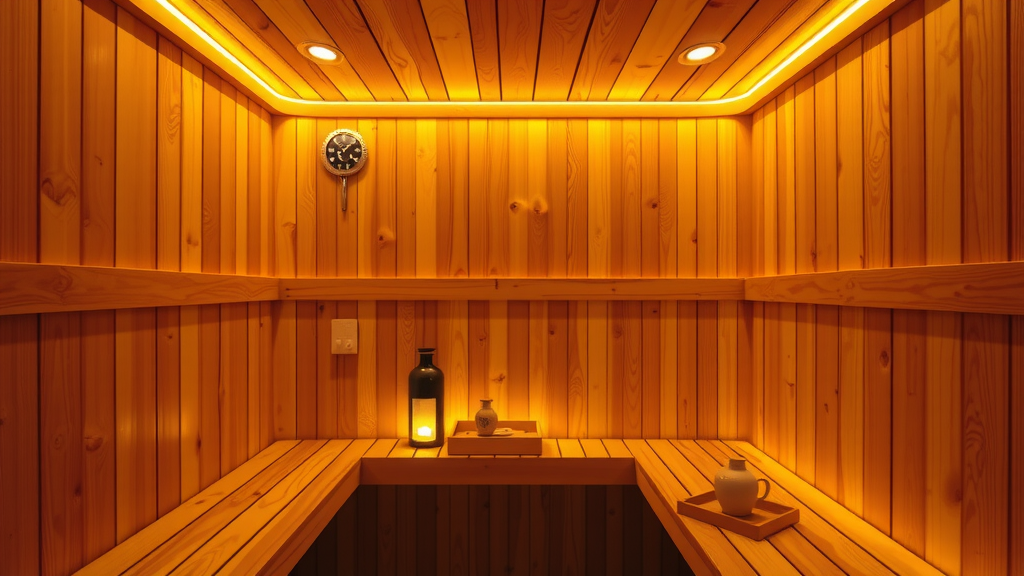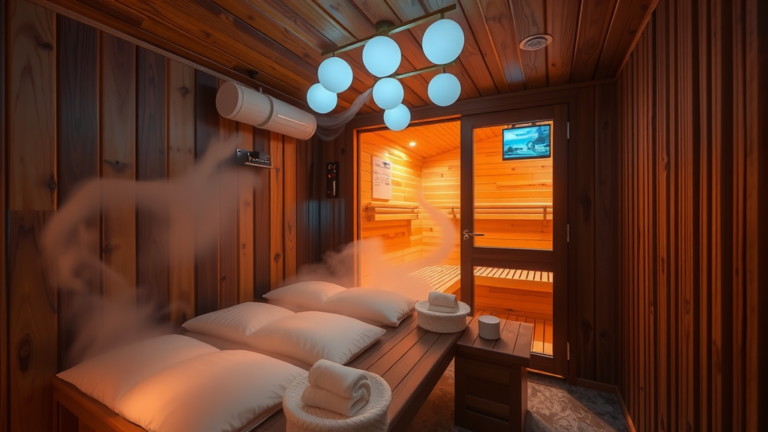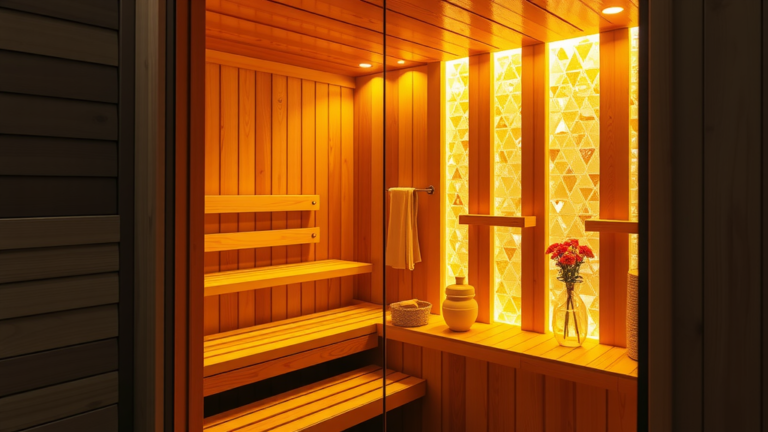
Prioritizing safety is crucial when using an infrared sauna. Hydration tips involve drinking water before, during, and after each sauna session.
Session duration should be restricted to 15-30 minutes, particularly for beginners.
Health precautions are necessary for individuals with medical conditions or pregnant women.
Detox benefits may be maximized through proper ventilation; ensure airflow and maintain temperatures between 120°F to 150°F. Regular maintenance not only enhances hygiene but also supports the effectiveness of relaxation techniques, providing a safer experience for users.
Click here to purchase a sauna on Amazon
Understanding Infrared Therapy Benefits
Infrared therapy offers a range of health advantages beyond traditional methods. By engaging in sweat therapy, individuals experience enhanced detoxification as the body produces increased sweat, effectively eliminating toxins.
Detoxification not only improves health but also supports overall wellness practices.
Relaxation plays a pivotal role, promoting mental well-being as stress levels decrease significantly.
Enhanced circulation aids muscle recovery, leading to improved vitality after physical exertion.
Improved circulation results from heightened blood flow, ensuring optimal oxygen delivery to tissues.
This enhancement of cardiovascular health can alleviate symptoms associated with chronic conditions. Proper hydration during sauna sessions addresses overheating risks while maximizing therapy effectiveness.
- Hydration:
- Hydration is important before, during, and after sauna use.
- Adequate hydration elevates the efficiency of sweat therapy.
- Considerations:
- Consult healthcare providers for special populations, such as pregnant women.
- Follow health advice for safe sauna experiences.

Key Health Precautions For Sauna Use
Utilizing infrared saunas can provide numerous health benefits, yet attention to safety is paramount. Health consultations with a healthcare provider are necessary for anyone who is pregnant or has pre-existing medical conditions.
Session guidelines recommend that beginners limit their time in the sauna to 15-30 minutes to mitigate the risk of overheating.
Hydration is imperative; maintaining fluid levels before, during, and after sauna usage ensures optimal safety and comfort.
Proper ventilation and effective temperature controls significantly contribute to enhancing user safety, creating a comfortable environment. Regular cleaning is an important measure to promote hygiene, while following comfort measures during sessions helps to protect against potential health risks.
Infrared Saunas
- Consulting a healthcare provider is essential for pregnant individuals and those with existing medical conditions.
- Beginners should limit sauna sessions to 15-30 minutes to prevent overheating.
- Staying hydrated before, during, and after sauna use is crucial for safety and comfort.
- Regular cleaning and proper ventilation enhance hygiene and user safety in sauna environments.
What Are Hydration Tips During Sessions
Hydration plays a significant role in enhancing sauna maintenance and overall health during sessions. Before entering the sauna, it is advisable to consume water or electrolyte-rich beverages at least 30 minutes ahead of time.
This preparation directly influences body monitoring and the comfort level experienced in the heat.
During the sauna session, keep water nearby to sip on periodically.
Avoid caffeine and alcohol, as these substances can contribute to increased fluid loss and hinder detoxification processes. After the session, it is critical to rehydrate immediately, paying attention to urine color to ensure it remains pale yellow, indicating proper fluid balance.
Implementing these hydration tips not only supports your sauna experience but also promotes wellness through effective heat acclimatization and recovery.
Importance Of Temperature Regulation In Saunas
Temperature management plays a significant role in optimizing the sauna experience. Infrared saunas operate effectively within a range of 120°F to 150°F, ensuring that hydration levels remain stable and user safety is prioritized.
Proper temperature regulation prevents overheating, which can lead to adverse health conditions and discomfort.
Users should always monitor their personal comfort and any existing health issues to adjust sauna temperatures accordingly.
Consistent and controlled sauna temperatures enhance relaxation and support effective detoxification methods, ultimately maximizing the health benefits associated with sauna use. Effective ventilation in infrared saunas is paramount, allowing for comfortable airflow and preventing excessive heat buildup.
Temperature Management in Infrared Saunas
- Infrared saunas are most effective at temperatures between 120°F and 150°F.
- Proper temperature regulation helps prevent overheating and associated health risks.
- Monitoring personal comfort levels is essential for a safe sauna experience.
- Effective ventilation is crucial for maintaining comfortable airflow and preventing heat buildup.
Safe Usage Guidelines For Infrared Saunas
To fully benefit from infrared sauna sessions, adhering to specific safety measures is essential. These recommendations can enhance your sauna experience significantly.
Hydration is critical; ensure adequate water intake before, during, and after use.
New users should limit their sauna sessions to 15-30 minutes to avoid discomfort.
Pregnant individuals must refrain from using infrared saunas to maintain their safety. Adequate ventilation is vital, as it regulates moisture levels and overall comfort.
Regular cleaning practices are necessary to prevent bacterial growth and ensure hygiene. Monitor your body’s response during sessions; exit immediately if feeling unwell.
Following these guidelines can support skin health and contribute to overall wellness while enjoying an infrared sauna.
How To Monitor Body Temperature Effectively
Effectively managing your core temperature throughout a sauna session promotes both safety and relaxation. Establish a routine employing a digital thermometer to check your body temperature prior to, during, and after each session.
Recognizing signs of overheating is vital, with symptoms such as dizziness and excessive sweating signaling the need for immediate action.
- Track session frequency: Limit sessions to 15-30 minutes, especially for individuals new to this wellness journey.
- Hydration is key: Maintain adequate hydration before, during, and after sauna use to support your overall health.
- Verify sauna conditions: Ensure proper ventilation and monitor temperature settings for an optimal relaxation space.
Incorporate regular breaks during your sauna experience to evaluate how your body responds to the heat. Consult a healthcare provider for tailored advice regarding sauna use, particularly if you have underlying medical conditions. By tracking body temperature effectively, your detox rituals transform into a more enjoyable and health-conscious practice.
- Regular sauna use can improve cardiovascular health and enhance circulation.
- Staying hydrated can help prevent heat-related illnesses and support overall body function.
- Monitoring body temperature can help prevent overheating and ensure a safe sauna experience.
- Consulting a healthcare provider can provide personalized guidelines for sauna use based on individual health needs.
Essential Postsauna Care Practices
To fully enjoy the advantages of a sauna experience, individuals must implement effective aftercare routines. Hydration plays a pivotal role immediately following a session, as the fluids lost through sweating must be replenished.
Recommendations advocate for consuming water before, during, and after sauna use to enhance personal wellness.
Incorporating stretching exercises is beneficial for promoting flexibility and aiding muscle relaxation.
Effective stretches should target major muscle groups to support recovery. After your sauna session, cooling down properly can prevent thermal shock; gradually reduce skin temperature through gentle air exposure.
Attention to safety considerations is paramount, especially for individuals who may be pregnant or those with specific medical conditions. Always assess your comfort levels to mitigate risks and enhance heat tolerance.
Tips For Gradual Exposure To Heat
Engaging with infrared saunas requires a clear understanding of heat exposure protocols for optimal safety. Hydration is essential before, during, and after sessions, as it helps maintain body temperature and supports natural healing processes.
Start with short sessions lasting 15-30 minutes to facilitate acclimatization gradually.
Monitor your body’s response closely; exit the sauna immediately if you experience any discomfort.
Pregnant women and individuals with specific medical conditions should seek medical advice prior to use.
Ensure proper ventilation to create a suitable detoxifying atmosphere, facilitating effective heat management.
- Limit initial sauna sessions to enhance acclimatization and minimize overheating risks.
- Maintain proper hygiene by cleaning the sauna regularly to ensure a safe environment.
- Consider wearing a towel for added comfort and to promote wellness.
- Avoid utilizing the sauna after consuming heavy meals or alcohol to optimize safety.
- Studies show that regular sauna use can improve cardiovascular health by enhancing circulation.
- Hydration is crucial, as the body can lose significant amounts of water through sweat during sauna sessions.
- Research indicates that infrared saunas may aid in muscle recovery and reduce pain and inflammation.
- Proper ventilation in saunas is essential to prevent overheating and ensure a comfortable experience.
Infrared Sauna Weight Loss Benefits
How To Use Infrared Saunas Effectively






